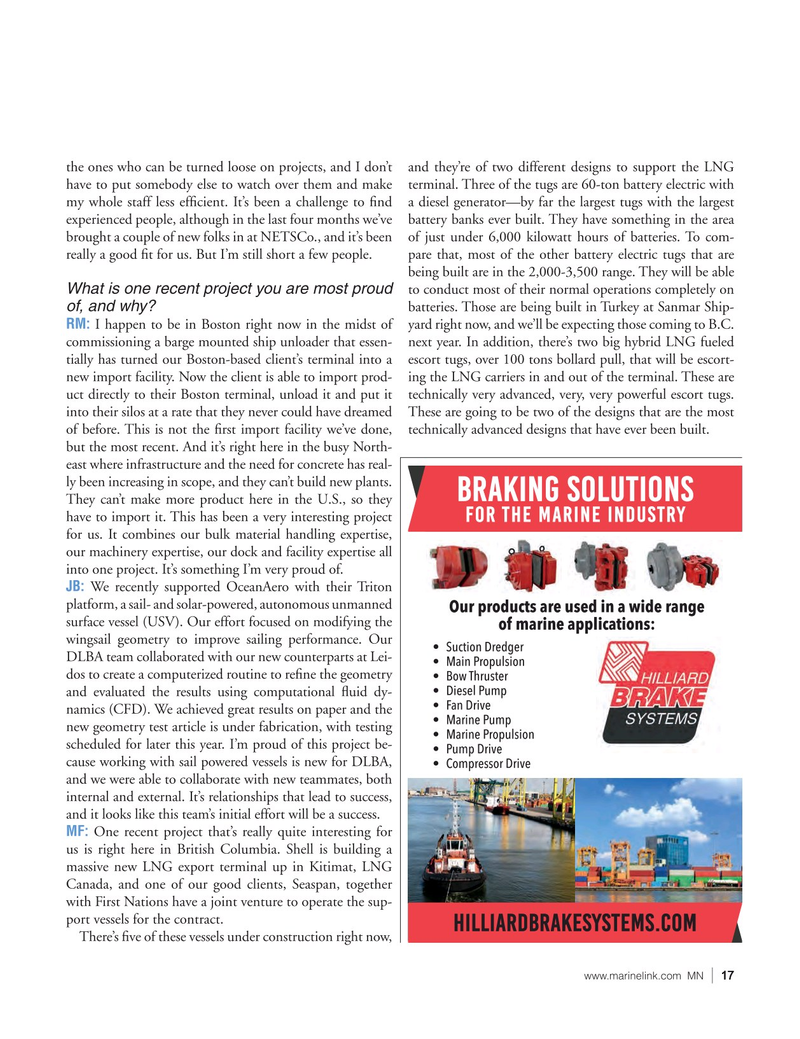
Page 17: of Marine News Magazine (September 2022)
Boatbuilding & Repair
Read this page in Pdf, Flash or Html5 edition of September 2022 Marine News Magazine
the ones who can be turned loose on projects, and I don’t and they’re of two different designs to support the LNG have to put somebody else to watch over them and make terminal. Three of the tugs are 60-ton battery electric with my whole staff less ef? cient. It’s been a challenge to ? nd a diesel generator—by far the largest tugs with the largest experienced people, although in the last four months we’ve battery banks ever built. They have something in the area brought a couple of new folks in at NETSCo., and it’s been of just under 6,000 kilowatt hours of batteries. To com- really a good ? t for us. But I’m still short a few people. pare that, most of the other battery electric tugs that are being built are in the 2,000-3,500 range. They will be able
What is one recent project you are most proud to conduct most of their normal operations completely on of, and why?
batteries. Those are being built in Turkey at Sanmar Ship-
RM: I happen to be in Boston right now in the midst of yard right now, and we’ll be expecting those coming to B.C. commissioning a barge mounted ship unloader that essen- next year. In addition, there’s two big hybrid LNG fueled tially has turned our Boston-based client’s terminal into a escort tugs, over 100 tons bollard pull, that will be escort- new import facility. Now the client is able to import prod- ing the LNG carriers in and out of the terminal. These are uct directly to their Boston terminal, unload it and put it technically very advanced, very, very powerful escort tugs. into their silos at a rate that they never could have dreamed These are going to be two of the designs that are the most of before. This is not the ? rst import facility we’ve done, technically advanced designs that have ever been built.
but the most recent. And it’s right here in the busy North- east where infrastructure and the need for concrete has real- ly been increasing in scope, and they can’t build new plants.
They can’t make more product here in the U.S., so they have to import it. This has been a very interesting project for us. It combines our bulk material handling expertise, our machinery expertise, our dock and facility expertise all into one project. It’s something I’m very proud of.
JB: We recently supported OceanAero with their Triton platform, a sail- and solar-powered, autonomous unmanned surface vessel (USV). Our effort focused on modifying the wingsail geometry to improve sailing performance. Our
DLBA team collaborated with our new counterparts at Lei- dos to create a computerized routine to re? ne the geometry and evaluated the results using computational ? uid dy- namics (CFD). We achieved great results on paper and the new geometry test article is under fabrication, with testing scheduled for later this year. I’m proud of this project be- cause working with sail powered vessels is new for DLBA, and we were able to collaborate with new teammates, both internal and external. It’s relationships that lead to success, and it looks like this team’s initial effort will be a success.
MF: One recent project that’s really quite interesting for us is right here in British Columbia. Shell is building a massive new LNG export terminal up in Kitimat, LNG
Canada, and one of our good clients, Seaspan, together with First Nations have a joint venture to operate the sup- port vessels for the contract.
There’s ? ve of these vessels under construction right now, www.marinelink.com MN 17|

 16
16

 18
18
